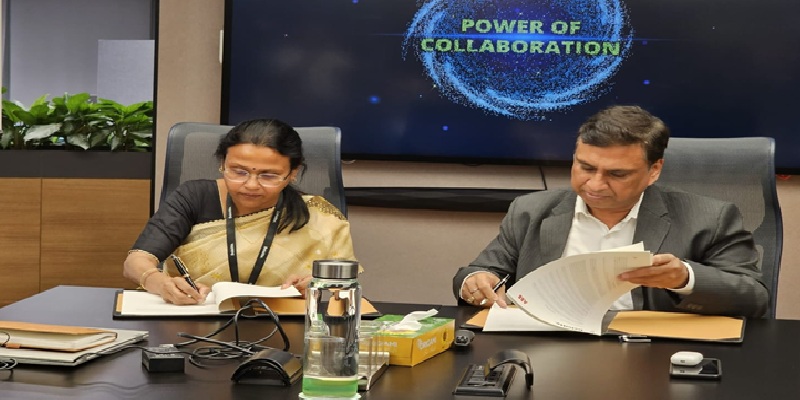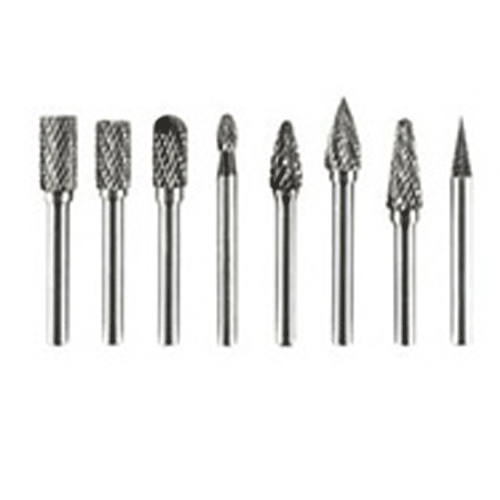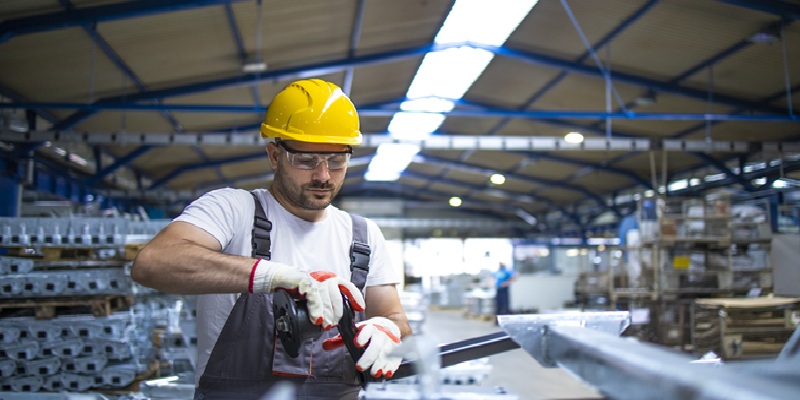Schedule a Call Back
Skilled labour: The missing link
 Articles
Articles- Mar 30,24

Recently, while speaking to one of the news channel, Chetan Ahya, Morgan Stanley's Chief Asia Economist, said that it was unlikely for India to match China's impressive economic growth rate of 8-10 per cent primarily due to infrastructure deficiencies and a shortage of skilled labour. Similar sentiment was echoed by Banmali Agrawala, Senior Adviser, Tata Sons Pvt Ltd, during a function organised by the NGO United Way of Chennai, who stated that India needs a skilled workforce to seize the opportunity in the global manufacturing trade, which is estimated at $ 15 trillion (with India accounting for less than 1 per cent share).
These observations are not exceptions, but widely articulated by industry experts. With India aiming to increase its exports share in the merchandised goods trade, availability of skilled labour will be important. “India's aspiration to become a $1 trillion manufacturing economy underscores the critical role of skilled labour in driving this monumental transformation. Skilled labour acts as the cornerstone of the manufacturing sector, providing expertise and precision vital for enhancing productivity, fostering innovation, and ensuring global competitiveness. The proficiency of skilled workers is instrumental in optimising production processes, thereby significantly contributing to product quality, operational excellence, and overall industry growth. This robust foundation of skilled labour is essential for sustaining India's manufacturing momentum and advancing its position on the global stage,” opines Ravichandran Purushothaman, President, Danfoss India.
Jibak Dasgupta, Director General & CEO, Indian Machine Tool Manufacturers' Association (IMTMA), adds, “Skilled labour is indispensable to attract and retain investments as more often than not investors zero in on locations that have availability of trained manpower in addition to other business needs that they look for.”
India: The fast growing labour market
According to a report of the US-based Reshoring Institute, while China is no longer the global low-cost labour market, India has emerged as one of the lowest-cost countries, along with Mexico and Vietnam, in terms of manufacturing wages. The report - which focused on global labour rates in 12 countries - found that when it comes to managers and supervisors, India and Vietnam are better performers than China.
Figure 1 (place this on Page 2)
Figure 1: Indicative annual salary in auto component industry
Though India offers competitive advantages with its lower wage structure and access to a vast labour market, pay scale varies depending on the factory location - typically wages in tier two and three cities are much lower than tier one. Auto industry, the largest contributor at 22 per cent of the manufacturing GDP and seven per cent of India’s overall GDP, is the biggest employer in the manufacturing sector. Figure 1 presents indicative pay scale for various position in auto component manufacturing plant in different places. Manufacturing hubs of auto OEMs and their suppliers are centered around tier two and three cities in the country such as Pune (Maharashtra), Gurgaon (Haryana), Chennai (Tamil Nadu), etc.
In the recent years, wage hikes in manufacturing have been consistently high compared to other sectors. According to AON’s Annual Salary Increase and Turnover Survey 2023-24 India (refer Table 1), the manufacturing sector is likely to lead pay hikes in 2024 with 10.1 per cent increase. Explaining the reason, Amit Kumar Otwani, Director, Talent Solutions, India, Aon, says, “The leading salary increase increments in the manufacturing sector is reflective of India’s promising growth story led by a strong push by the central government through initiatives be it Production Linked Incentive (PLI) schemes for 14 key sectors (with an incentive outlay of Rs 1.97 lakh crore) or the FAME subsidies for incentivising the growth of EV and EV batteries industry in India (with outlay of Rs 10,000 crore).This strategic move is further coincided with the geopolitical scenario putting the global supply chain at risk pushing global manufacturers to diversify their manufacturing bases – which in turn is leading to strong interest coming in for sectors like electronics, pharmaceuticals, semiconductors and chemical players.”
In the coming years, digital and niche skills are expected to dominate the sector. “Smart manufacturing jobs like automation, digitalization, lean manufacturing, digital twin engineering, simulation engineering and sustainable manufacturing will consequently be seeing hikes as they become increasingly relevant as manufacturing industry undergoes transformation,” observes Otwani.
Despite these job opportunities, industries in India are facing skill shortage, which is threatening the growth story.
Big gap between demand & supply
But, how grave is the problem of scarcity of manpower in manufacturing? Neeti Sharma, CEO, TeamLease Digital, answers, “The country is currently experiencing an alarming shortage of 150 million skilled workers, up from 138 million three years ago, according to TeamLease Services. The data from 2023 highlights a critical challenge we face: a severe shortage of skilled workers across multiple sectors, including our factories, engineering units, manufacturing plants, assembly lines, and infrastructure projects.”
The country is poised to maintain a growth trajectory of 6-8 per cent until 2035, solidifying its position as a key global manufacturing center. Given the rising demand for skilled workers in the manufacturing sector, the availability story is no match, she says.
According to Neeti Sharma, CEO, TeamLease Digital, the sector in specific suffers from lack of highly skilled talent for multiple reasons such as:
With 12 million young Indians entering the employable age every year, the country is projected to have 1.04 billion persons, in the employable age group, by 2030. Despite this huge demographic dividend, India is facing the challenge of shortage of skilled and semi-skilled labour. Otwani elaborates, “Despite its huge demographic dividend, India currently faces a significant scarcity of manpower, across multiple disciplines, including factories, engineering units, manufacturing and assembling plants etc. A report by the National Skill Development Corporation (NSDC) last year estimated that India's skilled labour demand touched 100 million in 2022, however the supply side fell short by a staggering 29 million workers.”
Similarly, Confederation of Indian Industries (CII) report, Decoding Jobs, in 2023 had estimated that there would be a gap of 68 per cent between demand and supply as there would be a significant reduction in the number of migrants returning to tier-1 cities in 2022 (compared over the previous year). The talent scarcity in white-collar jobs is evident across all levels, including entry-level, mid-level, and senior-level positions. Otwani states, “There are certain reasons which attribute to this occurrence including lack of vocational training in the Indian educational setup leading to the mismatch & low productivity. While there is growing reliance on technology & automation, the industry is getting handicapped with an unfulfilled demand for manpower capable of operating and maintaining them. Industries such as IT, Ecommerce, BPO, hospitality, etc have attracted workers away from a lower-paying factory job.”
Sushil Virmani, Managing Director, Best Power Equipments, adds, “As manufacturing technology evolves, it requires workers to have higher education and new skills. According to a recent study done by a workforce agency, the manufacturing industry is facing a lot of labour crisis. This is always a tough time with high unemployment, confusing schedules, frequent turnover and lack of skilled workers. Global health crises contribute to this, much like the COVID-19 pandemic impact, and employees retiring or transitioning into other sectors, for example - engineering and health care.”
Problem more acute in SMEs
Despite India's stature as one of the world's largest economies and its claim of having abundant pool of skilled professionals, small and medium-sized enterprises (SMEs) struggle to attract talent. Several factors contribute to this shortage of skilled workers, says Neeti Sharma.
One of the foremost challenges faced by SMEs is the escalation of costs coupled with declining revenues. This encompasses factors such as inflation, rising raw material expenses, escalating insurance premiums, subdued demand for products and services, and various other operational expenses.
Furthermore, she says, “SMEs often grapple with the loss of skilled employees to competitors, particularly larger firms within the same industries. While larger corporations can offer opportunities for personal growth and career stability, there are additional reasons why skilled individuals opt to depart from SMEs. This exacerbates another issue: the prevalence of a poor work culture. Many SMEs suffer from inadequate work environments, resulting in elevated rates of employee turnover.”
Smart factories need new skill sets
Increasing need to automate manufacturing processes to stay competitive in the market is leading to skill gaps. Otwani states, “Digital transformation and Industry 4.0 are revolutionising how the manufacturing operations work and hence, the skilled manufacturing talent is increasingly harder to come by. Research tells us exit 2028, close to 2.4 million manufacturing jobs will be unfilled. Hence, there is a shift on the talent and skills front which manufacturers need in order to succeed the factory of the future.”
According to him, while there are several manufacturing roles & skills that are undergoing change due to this trend, following roles are experiencing a particularly high level of evolution in the smart factory era.
“Consequentially, manufacturing companies are looking at skills such as data analytics, control and automation engineering, instrumentation engineering, systems engineering, simulation engineering, lean manufacturing, etc, while hiring employees for their factory setup,” says Otwani
Manufacturers are looking at following skills while hiring:
With industries adopting latest manufacturing technologies, it becomes critical for companies to invest in skilling, reskilling, and upskilling the workforce which can help them in maintaining the competitive edge.
For all those industries embracing digital and AI-powered technologies with open arms, there’s a caveat, cautions Dasgupta. “Deploying technology alone wouldn’t give their business an edge, they need to employ a skilled workforce who can understand and use the technologies. As we all know industries aren’t strangers to technological shifts, changing market dynamics, and regulatory procedures. They are aware of the awards to be reaped when a skilled workforce is employed for a certain assignment,” he states.
Dasgupta elaborates, “The skill set that will be crucial for the workforce to upgrade will be technical proficiency in AI, robotics, IoT and many other Industry 4.0 technologies; the ability to analyse and interpret complex data sets as part of digital literacy; the ability to predict and troubleshoot problems well in advance for more complex systems; adaptation and flexibility to new work environment, more exposed to collaborative work with cross-disciplinary subjects; and nurture a habit of continuous learning in a rapidly accelerating technological paradigm.”
Low participation of women in workforce
India’s manufacturing sector, which accounts for roughly 16-17 per cent of the national GDP, suffers from a serious gender imbalance. Neeti Sharma states, “This skew can derail the country’s larger economic ambitions like building a $ 5 trillion economy. Currently, the composition of women in Indian manufacturing is between 3 per cent (core engineering) to 12 per cent (other engineering streams), compared to over 30-40 per cent employment in the services sector.” While the numbers may seem low, she says, the trends for participation of women has been increasing over the years.
With an intention to expand the talent pool, many manufacturers in India are looking to increase women workforce - breaking down gender stereotypes in the work floor. For example, in Aditya Birla Group, women account for over 50 per cent of newly hired engineers on the shop floor. Similarly, JSW Steel's new colour-coated steel manufacturing facility in Pulwama (Kashmir), which is expected to be commissioned soon, will have more than 50 per cent women.
“More manufacturing organisations are employing women, particularly in the traditional leather, FMCG, textile, and automotive industries, as well as in developing fields like electric vehicles, battery electronics, and solar cell manufacture. Women workers are contributing to higher efficiency and productivity, along with lesser attrition. Given these factors, companies are increasingly investing in building workspaces that are safer for women and more inclusive of their needs. For example, work transport, hygienic work conditions, better pay, and gender inclusive policies,” observes Neeti Sharma.
In March 2024, TeamLease Degree Apprenticeship unveiled a data showcasing a monumental shift towards gender inclusivity in the manufacturing sector, which has witnessed a remarkable 5X increase in demand for female apprentices in the past 8-10 months. From traditional male-dominated manufacturing shop floor roles to future-of-work profiles involving AI, ML, and data sciences, women apprentices are being deployed to catapult organisational productivity and foster a positive work culture.
Tamil Nadu: The leading women employer
“Tamil Nadu is witnessing a surge in female employment, particularly within burgeoning industries such as electric vehicles, battery electronics, solar cell manufacturing, as well as in traditional sectors like leather, textile, and automobiles. Women are increasingly drawn to these opportunities due to several factors,” opines Neeti Sharma.
Firstly, Tamil Nadu boasts a women's workforce participation rate of 36.2 per cent, significantly surpassing the national average. Secondly, the state's commendable education levels among women contribute to their readiness for employment. Moreover, the decentralised nature of factories coupled with robust transportation infrastructure ensures accessibility to job opportunities. Safety, educational opportunities, and supportive family conditions serve as foundational reasons for women to enter the workforce. “Additionally, the women-friendly environment prevalent in industries such as weaving and spinning mills further motivates their participation. With factories strategically distributed across the state and the presence of women-centric growth centers in every district, Tamil Nadu sets a compelling precedent for fostering women's empowerment in the manufacturing domain,” she says.
Ravichandran of Danfoss India, which has manufacturing factory at Oragadam near Chennai, attributes, the success of Tamil Nadu (in promoting women's employment in factories) to its implementation of supportive policies that create an enabling environment for women to thrive in the manufacturing landscape. “Additionally, initiatives aimed at enhancing women's safety and welfare within factories play a pivotal role in attracting and retaining female workers, thereby fostering a secure and conducive work environment that prioritizes their well-being and comfort. Furthermore, Tamil Nadu's emphasis on cultivating inclusive and gender-diverse work environments promotes a culture of equality and empowerment, instilling a sense of belonging and encouraging greater female participation in the manufacturing industry,” he explains.
He adds, “By aligning its strategies with Tamil Nadu's progressive approach towards enhancing women's participation in factories, Danfoss actively contributes to bolstering the representation of women in the manufacturing workforce. This fosters a culture of diversity, equality, and empowerment within the organisation and the industry at large.”
The demand-supply gap of skilled manpower is more accentuated when there is increase in demand emanating from an equivalent enhancement of manufacturing capacity, comments Amit Kumar Otwani, Director, Talent Solutions, India, Aon. According to him, Indian organisations need to take significant steps to address this issue through some of the following channelised approaches:
Mission skilling
Manufacturing, electric vehicle, and engineering companies have been hiring at their fastest pace in the last five years. “The hiring intent for 2024 is 19.8 per cent, the highest since 2020, with a goal of creating 100 million jobs in the manufacturing sector by 2025. This implies that all repeat jobs will get automated, and that the manufacturing sector will steadily shift toward new-age, high-order, skill-intensive jobs,” opines Neeti Sharma.
The government has taken multiple steps for skill development, including establishing the National Skill Development Council (NSDC). Given the trajectory of the sector, NSDC - through its initiatives like Skill India, Sector Skills Council, National Apprenticeship Promotion Scheme (NAPS), etc - has bolstered the quality of talent for manufacturing. “NSDC has played a role of a catalyst in the skilling ecosystem and has nurtured private sector organisations to be part of the skilling value chain either as training partners, mobilizing partners, placement partners or encouraging innovations. This has particularly worked for manufacturing because the access to quality technical trainings has gotten better for the young people from Tier 2 or 3 cities who want to get employed. This is improving the quality of factory workers,” she explains.
Moreover, introduction of basic skills for new age industries has been pioneered by NSDC, especially for the automotive and textile sectors. “Skills of 3D printing, automotive technicians, analysts, textile specialists and AI/ML based roles have seen a higher uptake after the NSDC interventions across the ecosystem. In addition, the manufacturing sector has seen the highest enrollment of apprentices, who are gaining hands-on experience of operating machinery/ manufacturing units, which in turn increases their employability quotient. These initiatives have contributed to the movement from Industry 4.0 to Manufacturing 4.0, which demands that even the grey/blue collar workforce emerging from the ITIs is ready to join the Manufacturing 4.0 ecosystem. Yet, such a transformation is a generational one and requires public-private partnerships across the ecosystem,” opines Neeti Sharma.
Companies are also recognising the urgent need to prioritise employee training and upskilling. Virmani states, “Best Power Equipments (BPE) understands the significance of digital transformation and the use of technology to grow our workforce and yield better results at work. We continuously make efforts to improve our efficiency by reducing the impact of labour shortages through strategic planning and the utilisation of advanced technology. As we use automation to increase productivity, we understand that the proper alignment of hiring and training is critical to its success. We, therefore, prioritise routine equipment maintenance and enter into reciprocal manufacturing agreements with other companies to minimise the impact of mechanical failure on production. These strategies enable us to effectively address workforce challenges and build a resilient workforce for the future, ensuring continued success in growing manufacturing sectors.”
According to Dasgupta, manpower challenges could be addressed with the collaborative efforts of the government and industries. “Businesses need to invest in employee training and development programs, offer competitive wages and benefits to attract and retain the workforce, and collaborate with institutions to ensure that their employees are skilled. The government needs to provide sops (tax breaks and subsidies for training) and allocate funds for vocational training and educational initiatives to develop manufacturing skills. It also needs to streamline immigration policies to attract workers from overseas and fill the void. Research that drives innovation in manufacturing technologies should be supported,” he elaborates.
Building tech-talent
To foster skill development initiatives and enhance employability of the students, companies are also collaborating with educational institutes. Ravichandran opines, “Amidst the increasing demand for automation within the manufacturing sector, it is imperative for companies, the government, and the industry to collaborate on strategic initiatives aimed at equipping the workforce with the necessary skills to effectively integrate and optimize automation technologies. In this regard, Danfoss is actively involved in multifaceted initiatives to address this urgent need. Through investments in employee training, collaboration with academic institutions, and advocacy for supportive policies, Danfoss is making significant advancements towards ensuring that the manufacturing workforce is well-equipped to navigate the transformative shift towards automation. This ultimately strengthens the sector's overall readiness for the future.”
Jayasankar Kuruppal, Senior Vice President, Manufacturing, CEAT, says, “We are seeing a higher attrition in the last 2 years and are taking various innovative actions to bring the attrition down. We recruit fresh diploma holders from colleges and train them in class room setting as well as on the job. This has so far enabled us to meet our manpower requirement. We also leverage on digital mechanisms to address these issues with initiatives like faster onboarding, training of manpower and VR models for our critical assembly operations machine in which the operators are trained in a virtual environment. This has helped us reduce the overall training time by more than 30 per cent."
Companies are aligning their skill development initiatives to equip the workforce to proficiently utilise automation for enhancing productivity and operational excellence. For example, the Bajaj Group recently committed Rs 5,000 crore to social impact initiatives over five years with a sharp focus on skill development under the ‘Bajaj Beyond’ initiative. Through the Bajaj Engineering Skills Training (BEST) programme (launched in 2023), the company aims to enhance the skills of engineering and diploma graduates in the latest technologies relevant to Industry 4.0.
Companies by investing in training and development programs can help their employees acquire skills needed to do well in an increasingly automated and technology-driven workspace. “Cybersecurity awareness is crucial to pre-empt threats and protect sensitive data. Also, workers need to be made aware of environmental, social, and governance (ESG) norms and implement eco-friendly initiatives to sustain themselves in the market,” observes Dasgupta.
Making workforce future-ready
With manufacturing evolving rapidly as a ‘new-age’ and ‘green’ ecosystem, it needs to attract talented manpower. The industry in itself is catching up with the innovations and moving from the traditional set-up, which implies that the workforce at large will too. “Companies can address this by offering on-the-job trainings, apprenticeships, and hire-train-deploy solutions to ensure that the foundation skills required are instilled and assessed right from the beginning. Such investment signals to the employable talent that the sector is ready to partner in their success. Laterally, within companies, there is a need to upskill current employees so they can step into the new opportunities without feeling overwhelmed/outdated. A fundamental set of ‘smart skills’ or ‘new age’ skills can be imparted to many teams, appealing to their readiness,” says Neeti Sharma.
She adds, “R&D remains a core focus area for manufacturing, and as a result dissemination of the knowledge to companies and institutions remains a responsibility for research bodies and the government. Research knowledge consumed the right way can empower the talent of today to join the sector. Lastly, a building inclusive and safe ecosystem is emerging a top priority for the sector, which demands attention from policy makers. Ensuring more women and PWD (people with disabilities) join the sector is an industry wide movement which can be delivered in partnership with the government.”
Companies will have to invest proactively in skill development not only enhance their talent pool but also significantly enrich India's manufacturing capabilities and bolster its competitive edge in the global market. Only workforce proficiency can catalyse India's path to a $1 trillion manufacturing economy.
Ravichandran Purushothaman, President, Danfoss India
Skilled labour acts as the cornerstone of the manufacturing sector, providing expertise and precision vital for enhancing productivity, fostering innovation, and ensuring global competitiveness.
Jibak Dasgupta, Director General & CEO, IMTMA
Skilled labour is indispensable to attract and retain investments as more often than not investors zero in on locations that have availability of trained manpower in addition to other business needs that they look for.
Amit Kumar Otwani, Director, Talent Solutions, India, Aon
While there is growing reliance on technology & automation, the industry is getting handicapped with an unfulfilled demand for manpower capable of operating and maintaining them.
Neeti Sharma, CEO, TeamLease Digital
With factories strategically distributed across the state and the presence of women-centric growth centers in every district, Tamil Nadu sets a compelling precedent for fostering women's empowerment in the manufacturing domain.
Sushil Virmani, MD, Best Power Equipments
As manufacturing technology evolves, it requires workers to have higher education and new skills. According to a recent study done by a workforce agency, the manufacturing industry is facing a lot of labour crisis.
Jayasankar Kuruppal, Sr VP, Manufacturing, CEAT
We are seeing a higher attrition in the last 2 years. We recruit fresh diploma holders from colleges and train them in class room setting as well as on the job. This has so far enabled us to meet our manpower requirement.
Related Stories

ARAPL Order Book Grows Over 16 per cent Year on Year, Exceeding Rs 1.40 Bn
In the first half of FY26, ARAPL executed orders worth Rs 0.426 billion, reinforcing its operational scalability and execution capabilities.
Read more
Tamil Nadu Signs 158 MoUs Worth Rs 438.44 Bn at TN Rising
State secures major investments across aerospace, semiconductors and advanced tech.
Read more
ABB India and Deloitte Form Alliance to Advance Digital Transformation
By embracing Artificial Intelligence (AI)-enabled digital and automation solutions, connected operations and data-led insights, Indian enterprises are well positioned to redefine efficiency, product..
Read moreRelated Products

Carbide Burrs
SRT Industrial Tools & Equipments offers a wide range of carbide burrs.

Jamshedji Soil Compactor
Jamshedji Constro Equip Pvt Ltd offers a wide range of jamshedji soil compactor.

Ground Pins
Hans Machineries Private Limited offers a wide range of pins, hardened & ground. Read more














